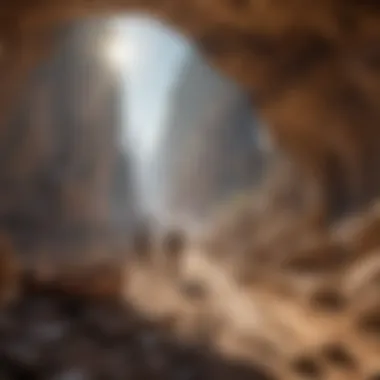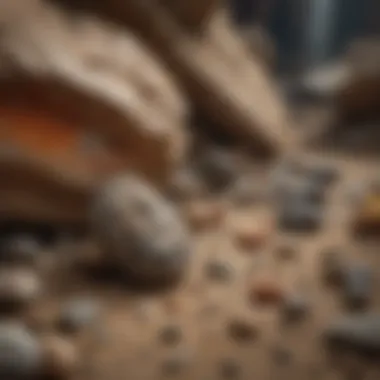Unveiling the Mesmerizing World of Rock and Fossil Collection: An In-Depth Guide


Rock and Fossil Identification
Rock and fossil identification is a fundamental aspect of delving into the captivating world of rock and fossil collecting. Enthusiasts are required to familiarize themselves with various types of rocks and fossils to distinguish between them accurately. By understanding the key characteristics to look for in different specimens, collectors can hone their expertise. Additionally, having the appropriate tools for identification, such as magnifying glasses, rock hammers, and field guides, enhances the precision of the process.
Collecting Tips and Techniques
To excel in rock and fossil collecting, enthusiasts must adopt best practices for efficient and ethical specimen collection. This includes obtaining necessary permits, respecting private property, and prioritizing the preservation of natural habitats. Locating prime collecting sites involves thorough research, geological knowledge, and networking with fellow collectors. When extracting specimens, it is vital to prioritize safety by using protective gear and following proper excavation techniques to avoid damage to the specimens or the environment.
Preservation and Display
Preserving rocks and fossils requires meticulous care and attention to detail to maintain their integrity for future generations. Techniques such as cleaning with proper tools, such as soft brushes and water, and avoiding harmful substances are imperative for preservation. Proper storage methods involve using archival-quality materials, such as acid-free paper and containers, to prevent deterioration. Collectors can explore creative display ideas, such as shadow boxes or specialized stands, to showcase their prized specimens effectively.
Geological Insights
Understanding geological formations and processes is essential for rock and fossil collectors to appreciate the context of their finds. Exploring the historical significance of rocks and fossils provides insights into the Earth's past and evolution over millions of years. Delving into notable discoveries in the field offers inspiration and knowledge about groundbreaking contributions to science and our understanding of the planet's history.
Introduction
In the expansive realm of rock and fossil collecting, the introduction serves as a crucial gateway to understanding the intricacies and wonders of this field. It sets the foundation for enthusiasts of varying experience levels to delve into a world brimming with ancient treasures and geological marvels. This pivotal section not only outlines the key aims and discussions of the article but also ignites a sense of curiosity and exploration that will resonate throughout the entire narrative.
Overview of Relict
Vibe Web Portal
Brief Description of Relict
Vibe
Embarking on the exploration of the RelictVibe web portal unveils a multifaceted platform designed to cater to the discerning needs of rock and fossil collectors. With a streamlined interface and a wealth of rich features, RelictVibe stands out as a paramount choice for enthusiasts seeking to enhance their knowledge and engagement within the community. Its seamless navigation and comprehensive database of resources make it a go-to hub for individuals looking to amplify their collecting endeavors.
Detailed Description of Relict
Vibe
At the core of RelictVibe lies a detailed repository of information, offering in-depth insights into various geological formations, preservation techniques, and specimen identification. Users can immerse themselves in a plethora of articles, tutorials, and interactive tools, providing a holistic learning experience that transcends conventional boundaries. Its user-friendly interface and expertly curated content make it an indispensable companion for collectors of all proficiency levels.
Target Audience of Relict
Vibe


Tailored to cater to a diverse audience of rock and fossil enthusiasts, the RelictVibe web portal appeals to novices, seasoned collectors, and experts alike. Its accessibility and relevance to individuals passionate about Earth sciences make it a sought-after resource for those looking to expand their knowledge, connect with like-minded individuals, and delve deeper into the captivating world of geological wonders.
Purpose of the Article
Informing and Educating Enthusiasts
The primary objective of this article is to serve as a beacon of knowledge, enlightening enthusiasts about the nuances of rock and fossil collecting. By offering comprehensive explanations, practical tips, and expert advice, readers are empowered to deepen their understanding of geological formations, preservation techniques, and ethical collection practices. This segment serves as a cornerstone for individuals seeking to enrich their expertise and appreciation for the Earth's ancient history.
Exploring the World of Collection
Through a meticulous exploration of various collecting aspects, this article aims to unravel the intricate tapestry of Earth's geological heritage. From identifying rare specimens to understanding the environmental contexts in which they were formed, readers are guided on a captivating journey through time and space. By delving into the diverse facets of rock and fossil collecting, enthusiasts are encouraged to broaden their horizons and cultivate a deeper connection with the natural world.
Promoting Community Engagement
Central to the ethos of this article is the encouragement of community collaboration and knowledge sharing among rock and fossil collectors. By fostering a sense of camaraderie and collective learning, readers are prompted to engage with their peers, exchange insights, and contribute to a vibrant ecosystem of discovery. Through promoting active participation and dialogue, this article seeks to strengthen the bonds within the collecting community, creating a dynamic network of individuals united by their passion for Earth sciences.
Getting Started in Rock and Fossil Collecting
When embarking on the journey into the captivating realm of rock and fossil collecting, it is crucial to start on the right footing. Getting started in this enriching hobby involves delving into the Earth's history, uncovering unique specimens, and connecting with fellow enthusiasts. In this comprehensive guide on rock and fossil collecting, the section 'Getting Started' sets the foundation for an exciting exploration that awaits all who are passionate about geological wonders.
Essential Tools and Equipment
Hammer and Chisel
In the realm of rock and fossil collecting, the hammer and chisel stand as iconic tools essential for extracting specimens from their geological embrace. The hammer's sturdy blow paired with the precision of the chisel allows collectors to carefully extract fossils and rocks without damaging the delicate structures within. Their symbiotic relationship ensures that collectors can uncover treasures embedded within the earth's layers with finesse and accuracy. While the hammer provides the necessary force, the chisel's sharp edge enables controlled splitting, making them indispensable companions in the collector's toolkit. Their versatility in breaking rocks, splitting fossils, and revealing hidden details makes them popular choices for enthusiasts looking to kickstart their collection expeditions.
Brushes and Picks
When it comes to the meticulous work of uncovering delicate fossils or intricate rock formations, brushes and picks take the spotlight. Brushes, with their gentle bristles, allow collectors to sweep away sediment and dust without causing any damage to the specimens. Picks, on the other hand, provide precision in excavating fossils from surrounding rock layers or loosening stubborn debris blocking a potential find. The combination of brushes and picks offers a delicate yet effective approach to handling specimens without altering their natural state, making them essential tools for collectors aiming to preserve the integrity of their discoveries.
Safety Gear
While the thrill of discovery fuels the passion for rock and fossil collecting, safety should always remain a top priority. Safety gear, including goggles, helmets, and sturdy gloves, plays a crucial role in protecting collectors from potential hazards during excavation and handling of specimens. Goggles shield the eyes from flying debris, helmets offer head protection in rocky terrains, and gloves provide a barrier against sharp edges or rough surfaces. By prioritizing safety gear, collectors can delve into their pursuits with peace of mind, knowing that they are equipped to navigate rocky landscapes and unearth fossils without compromising their well-being.
Preservation and Display
In the realm of rock and fossil collecting, Preservation and Display play a crucial role in safeguarding and showcasing the precious specimens obtained during expeditions. Preservation ensures that the integrity and authenticity of fossils and rocks are maintained for future generations of enthusiasts to admire and study. Display, on the other hand, serves as a means of conveying the beauty and educational value of these ancient artifacts to a broader audience. This section delves into the significance of Preservation and Display within the context of this comprehensive guide.
Cleaning and Caring for Specimens
Tools for Cleaning


When it comes to cleaning fossils and rocks, having the right tools is paramount in ensuring thorough yet gentle maintenance. Precision brushes, soft-tipped picks, and mild cleaning solutions are essential for removing dirt and debris without damaging delicate surfaces. The meticulous use of these tools is vital for preserving intricate details and textures on specimens, contributing to the overall quality of the collection portrayed in this article.
Storage Tips
Effective storage plays a pivotal role in maintaining the longevity and condition of collected fossils and rocks. Proper storage techniques such as utilizing acid-free paper, cushioned containers, and temperature-controlled environments help prevent deterioration and minimize the risk of breakage. These storage tips not only protect the specimens but also enhance their preservation value, aligning with the core principles of this article.
Avoiding Damage
Avoiding damage is a key concern for rock and fossil collectors, as mishandling can irreparably harm valuable specimens. By employing careful handling techniques, implementing padding during transportation, and avoiding exposure to harsh elements, collectors can significantly reduce the risk of damage. This proactive approach to safeguarding specimens underscores the commitment to responsible collecting advocated throughout this article.
Display Techniques
Mounting Options
Selecting the appropriate mounting options is essential for effectively showcasing collected fossils and rocks. Display stands, shadowboxes, and custom mounts provide versatile choices for highlighting the unique characteristics and scientific significance of each specimen. The versatility and aesthetic value of these mounting options enhance the overall presentation of the collection, aligning with the visual appeal and educational goals emphasized in this article.
Lighting Considerations
Lighting plays a crucial role in accentuating the details and colors of exhibited fossils and rocks. Proper lighting techniques, such as using LED bulbs with adjustable settings and avoiding direct sunlight exposure, help create a visually engaging display while minimizing the risk of damage from UV rays. Careful consideration of lighting factors enhances the overall viewing experience for enthusiasts, promoting a deeper appreciation for the specimens highlighted throughout this article.
Creating Aesthetic Arrangements
Crafting aesthetically pleasing arrangements is key to captivating audiences and conveying the narrative of a rock and fossil collection. Utilizing principles of symmetry, color contrast, and thematic grouping allows collectors to create visually cohesive displays that tell a compelling story. By paying attention to detail and spatial organization, collectors can elevate the presentation of their specimens to evoke intrigue and admiration among viewers, reflecting the artistic and educational purpose of this article.
Understanding Geological Formations
Understanding Geological Formations plays a pivotal role in guiding rock and fossil collectors towards a deeper comprehension of the Earth's history and the intricate processes that have shaped it. By dissecting different types of rocks, fossils, and minerals, collectors can unlock a treasure trove of knowledge embedded within these geological formations. This section is crucial as it lays the foundation for enthusiasts to distinguish various specimens, interpret their significance, and appreciate the interconnectedness of geological events.
Types of Rocks and Fossils
Sedimentary, Igneous, and Metamorphic Rocks
Sedimentary, Igneous, and Metamorphic Rocks represent the fundamental building blocks of Earth's crust. Sedimentary rocks such as sandstone and limestone provide insights into past environments and ancient climates. Igneous rocks like granite and basalt offer glimpses of volcanic eruptions and molten processes deep within the Earth. Metamorphic rocks such as marble and gneiss showcase the transformative power of heat and pressure over time. Each rock type carries distinct characteristics that allure collectors seeking to expand their geological knowledge.
Plant and Animal Fossils
Plant and Animal Fossils hold the key to reconstructing prehistoric ecosystems and understanding the evolution of life on Earth. From fossilized leaves to dinosaur bones, these remnants serve as time capsules preserving biological remains that date back millions of years. Studying plant and animal fossils provides collectors with a tangible connection to the past, unraveling the mysteries of ancient flora and fauna that once roamed the planet.
Mineral Specimens


Mineral Specimens exhibit a dazzling array of colors, crystal structures, and chemical compositions that mesmerize collectors worldwide. From quartz and amethyst to pyrite and calcite, minerals offer a glimpse into the Earth's diverse mineralogy. Collectors admire mineral specimens for their visual allure, geological significance, and scientific value in understanding processes such as crystal formation, mineral identification, and rock formation.
Interpreting Geological Significance
Environmental Clues
Environmental Clues embedded within rocks and fossils serve as indicators of past landscapes, climates, and ecosystems. By analyzing sedimentary layers, fossil distributions, and geological structures, collectors can reconstruct ancient environments and decipher geological narratives. Environmental clues offer valuable insights into the Earth's history, highlighting the dynamic changes that have occurred over millions of years.
Historical Context
Historical Context provides a narrative framework for understanding the temporal sequence of geological events and evolutionary processes. By contextualizing geological formations within specific time periods, collectors can piece together the puzzle of Earth's history and evolution. Historical context enriches the interpretation of rocks and fossils, shedding light on their origin, age, and significance in the broader context of geological time.
Scientific Applications
Scientific Applications of geological findings extend beyond collector's cabinets into laboratories and research institutions. Geological specimens contribute essential data to fields such as paleontology, geology, and environmental science. By applying scientific methods such as dating techniques, geochemical analysis, and microscopy, collectors play a vital role in advancing our understanding of Earth's past, present, and future.
Advanced Collecting Strategies
In the realm of rock and fossil collecting, Advanced Collecting Strategies play a pivotal role in enhancing the overall experience and success of enthusiasts. These strategies delve deeper into networking, trading, and specialized techniques that elevate the collector's proficiency and collection quality. By focusing on Advanced Collecting Strategies, collectors gain a competitive edge, access to rare specimens, and opportunities for collaborative learning and research. Embracing these strategies fosters a sense of community and facilitates knowledge exchange within the collector network, promoting growth and innovation in the field.
Networking and Trading
Online Platforms
Online platforms have revolutionized the way rock and fossil collectors connect, trade, and showcase their specimens. These digital spaces serve as virtual galleries, allowing collectors to display their finds, engage in trades, and interact with a global community of like-minded individuals. The convenience of online platforms enables collectors to access a vast array of specimens, diversifying their collections and expanding their knowledge base. However, it is crucial for collectors to exercise caution and verify the authenticity of specimens and sellers to avoid fraudulent transactions.
Local Clubs and Events
Local clubs and events provide collectors with valuable opportunities to network, learn, and share their passion for rocks and fossils with fellow enthusiasts. These gatherings offer a sense of community and belonging, fostering friendships and mentorship opportunities within the hobby. Attending local clubs and events also opens doors to field trips, workshops, and guest lectures, enriching collectors' understanding of geological science and specimen identification. By participating in local clubs and events, collectors not only expand their knowledge but also contribute to the preservation and promotion of rock and fossil collecting as a recognized hobby and academic pursuit.
Ethical Trading Practices
Ethical trading practices are essential in maintaining the integrity and sustainability of the rock and fossil collecting community. Collectors should prioritize ethical considerations when acquiring specimens, ensuring that items are obtained through legal and responsible means. By adhering to ethical trading practices, collectors contribute to conservation efforts, protect cultural heritage, and support the ethical treatment of both living and extinct organisms. Engaging in fair and transparent trade practices not only upholds the values of the collecting community but also safeguards the reputation and future of rock and fossil collecting as a respected pursuit.
Specialized Techniques
Microscopy and Analysis
Microscopy and analysis are indispensable tools for rock and fossil collectors seeking to dive deeper into the structure, composition, and history of their specimens. Through high-powered microscopes and analytical methods, collectors can unravel the intricate details of rocks, fossils, and minerals, identifying unique features and geological clues. Microscopy enables collectors to explore microscopic worlds within their specimens, uncovering hidden gems and unlocking valuable insights into geological processes and historical contexts. By harnessing the power of microscopy and analysis, collectors enhance their research capabilities, furthering their understanding of the earth's rich and ancient history.
Reconstruction Methods
Reconstruction methods offer collectors a means to reconstruct and restore fragmented or damaged specimens, breathing new life into ancient treasures. From fossil preparation to specimen reconstruction, collectors can employ various techniques to reconstruct the original form and structure of their finds. These methods require precision, patience, and expert craftsmanship to ensure accurate restoration while preserving the integrity and scientific value of the specimens. By mastering reconstruction methods, collectors not only elevate the visual appeal of their collections but also contribute to ongoing scientific research and education within the rock and fossil collecting community.
Collaborative Research
Collaborative research transcends individual collecting endeavors, uniting collectors, scientists, and enthusiasts in shared pursuits of discovery and knowledge. By collaborating on research projects, collectors can contribute their findings, expertise, and resources to broader scientific investigations and conservation initiatives. Collaborative research fosters interdisciplinary dialogue, encourages data sharing, and promotes transparency within the collecting community, fueling innovation and advancements in geological and paleontological studies. Through collaborative research efforts, collectors have the opportunity to make meaningful contributions to scientific knowledge, participate in groundbreaking discoveries, and leave a lasting impact on the field of rock and fossil collecting.







